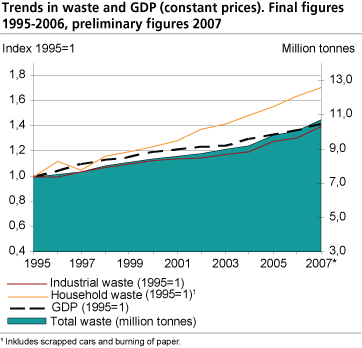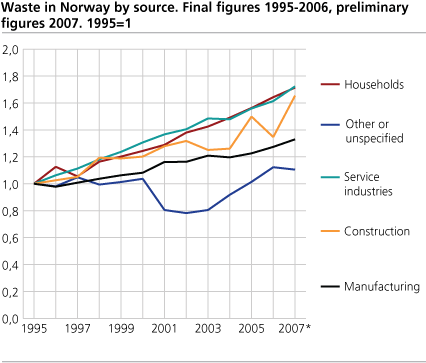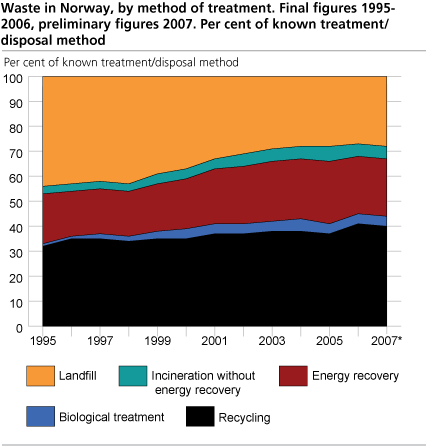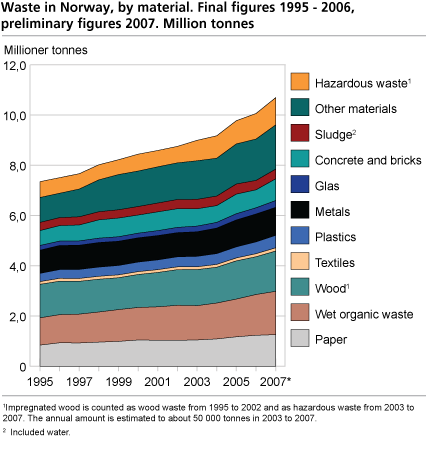Content
Published:
This is an archived release.
Rising volumes of waste in 2007
Norwegian enterprises and households generated 10.7 million tonnes of waste in 2007, after an increase of 6 per cent from the previous year. The growth in waste amounts has now surpassed the economic growth, as expressed by the GDP, due to a substantial rise in industrial waste over the last three years.
Waste volumes in Norway have increased every year since 1995, with the highest growth in the last three years, by 17 per cent in total. The increase is due to a rise in the amount of industrial waste, accounting for 80 per cent of the total waste. In contrast, the Norwegian gross domestic product (GDP) has increased by 9 per cent in the last three years. The amount of household waste has grown steadily since 1995, by 71 per cent in total, exceeding both the growth in the GDP (42 per cent) and the growth in household consumption (63 per cent).
Some figures may differ from the previous release, due to new and improved data.
Large amounts from industry
The service industries generated 1.8 million tonnes of waste in 2007, making up 17 per cent of the total amount. These figures include the sewage and refuse disposal industry. The service industries had the fastest growth among the waste sources, by 72 per cent since 1995; slightly faster than the households. Near half of the waste came from wholesale and retail trade.
The largest waste source was the manufacturing industries, with an estimated 3.9 tonnes in 2007. This comprised 36 per cent of the total for this year. The amount of manufacturing waste has expanded by 0.4 million tonnes over the last three years. However, the share of total waste generated from manufacturing has declined during recent years.
Construction and demolition accounted for 1.5 million tonnes of waste last year, after an estimated increase by as much as 31 per cent over the last three years. The construction and demolition industry generated 14 per cent of the total waste in 2007, of which about three quarters consisted of inert materials like concrete, bricks, asphalt and polluted soil and gravel.
Recovery remains high
In 2007, the recovery rate for non-hazardous waste in Norway was 67 per cent. Waste for which the treatment method is unknown is excluded. Even though the recovered amount has increased, the recovery rate has stabilised at 66 to 68 per cent since 2003.
The amount of waste being landfilled in 2007 was 3.1 million tonnes, including hazardous waste. Biodegradable materials made up 0.7 million tonnes of this, causing future emissions of the greenhouse gas methane. The 2006 emissions of methane from landfills comprised 2.5 per cent of the total Norwegian greenhouse gas emissions.
High quantities of food and slaughterhouse waste
The amount of wet organic waste reached 1.7 million tonnes last year, after a 21 per cent growth since 2004. Except for “other/unspecified materials”, this was the largest share of material in 2007. The manufacturing industries generated about 0.7 million tonnes of wet organic waste, mainly slaughterhouse waste, sludge from dairies and other production residues from food manufacturing. Household waste constituted 0.5 million tonnes, primarily waste from cooking, leftovers and expired food, but also small amounts of garden waste. The amount generated in the service industries was 0.4 tonnes, with retail trade, hotels, restaurants, hospitals, institutions and canteens as the main contributors.
The fastest growing share of material is concrete, with an increase of 21 per cent from the previous year. An increase in building and construction activities is assumed to be the main cause. The category “other/unspecified materials”, comprising 16 per cent of the total amount, contains material types like slag, asphalt, contaminated soil and gravel, rubber and porcelain.
| Total1 |
Paper, cardboard
and pasteboard |
Metals | Plastics | Glas | Wood waste | Textiles |
Wet
organic waste |
Concrete
and bricks |
Sludge | Other |
Hazardous
waste |
||||||||||||||||||||||||||||
|---|---|---|---|---|---|---|---|---|---|---|---|---|---|---|---|---|---|---|---|---|---|---|---|---|---|---|---|---|---|---|---|---|---|---|---|---|---|---|---|
| 1995 | 7 347 | 841 | 922 | 327 | 189 | 1 333 | 109 | 1 086 | 592 | 325 | 992 | 630 | |||||||||||||||||||||||||||
| 1996 | 7 506 | 934 | 959 | 349 | 174 | 1 332 | 113 | 1 119 | 615 | 320 | 970 | 620 | |||||||||||||||||||||||||||
| 1997 | 7 663 | 928 | 962 | 360 | 172 | 1 305 | 115 | 1 147 | 634 | 325 | 1 104 | 611 | |||||||||||||||||||||||||||
| 1998 | 8 020 | 961 | 977 | 366 | 174 | 1 305 | 116 | 1 199 | 728 | 324 | 1 270 | 601 | |||||||||||||||||||||||||||
| 1999 | 8 220 | 990 | 964 | 374 | 180 | 1 267 | 115 | 1 266 | 744 | 330 | 1 400 | 591 | |||||||||||||||||||||||||||
| 2000 | 8 442 | 1 046 | 965 | 380 | 186 | 1 313 | 113 | 1 294 | 721 | 340 | 1 412 | 672 | |||||||||||||||||||||||||||
| 2001 | 8 588 | 1 035 | 968 | 388 | 197 | 1 368 | 112 | 1 330 | 747 | 352 | 1 440 | 651 | |||||||||||||||||||||||||||
| 2002 | 8 752 | 1 033 | 962 | 400 | 210 | 1 420 | 111 | 1 393 | 743 | 366 | 1 458 | 657 | |||||||||||||||||||||||||||
| 2003 | 8 993 | 1 048 | 978 | 414 | 227 | 1 437 | 111 | 1 364 | 688 | 377 | 1 535 | 814 | |||||||||||||||||||||||||||
| 2004 | 9 173 | 1 088 | 1 015 | 430 | 227 | 1 425 | 113 | 1 428 | 668 | 379 | 1 506 | 894 | |||||||||||||||||||||||||||
| 2005 | 9 774 | 1 173 | 1 070 | 441 | 248 | 1 520 | 117 | 1 502 | 781 | 403 | 1 595 | 924 | |||||||||||||||||||||||||||
| 2006 | 10 100 | 1 200 | 1 100 | 470 | 250 | 1 500 | 120 | 1 600 | 710 | 370 | 1 600 | 1 020 | |||||||||||||||||||||||||||
| 2007* | 10 700 | 1 300 | 1 100 | 500 | 270 | 1 600 | 130 | 1 700 | 860 | 390 | 1 800 | 1 090 | |||||||||||||||||||||||||||
| By source and material (2006) | |||||||||||||||||||||||||||||||||||||||
| Total | 10 059 | 1 233 | 1 109 | 471 | 248 | 1 503 | 121 | 1 622 | 715 | 374 | 1 647 | 1 017 | |||||||||||||||||||||||||||
| Households2 | 2 050 | 463 | 238 | 143 | 66 | 355 | 51 | 499 | 0 | - | 206 | 30 | |||||||||||||||||||||||||||
| Agriculture, forestry and fishing | 157 | 6 | 14 | 15 | - | - | 4 | 114 | - | - | - | 1 | |||||||||||||||||||||||||||
| Mining and quarrying | 215 | 9 | 26 | 3 | - | 10 | - | 8 | 7 | - | 9 | 141 | |||||||||||||||||||||||||||
| Manufacturing | 3 725 | 187 | 204 | 67 | 44 | 697 | 12 | 642 | 122 | 270 | 984 | 496 | |||||||||||||||||||||||||||
| Electricity, gas and water supply | 46 | 2 | 5 | - | - | 2 | - | - | 1 | - | 2 | 33 | |||||||||||||||||||||||||||
| Construction | 1 258 | 15 | 53 | 13 | 70 | 191 | - | - | 581 | - | 292 | 15 | |||||||||||||||||||||||||||
| Service industries | 1 673 | 463 | 99 | 145 | 43 | 192 | - | 335 | 4 | 104 | 153 | 87 | |||||||||||||||||||||||||||
| Other or unspecified | 935 | 88 | 471 | 84 | 23 | 54 | 1 | - | - | - | 0 | 214 | |||||||||||||||||||||||||||
| By treatment/disposal and material (2006) | |||||||||||||||||||||||||||||||||||||||
| Total | 10 059 | 1 233 | 1 109 | 471 | 248 | 1 503 | 121 | 1 622 | 715 | 374 | 1 647 | 1 017 | |||||||||||||||||||||||||||
| Material recovery | 3 119 | 670 | 966 | 63 | 111 | 350 | 13 | 485 | 87 | 90 | 265 | 18 | |||||||||||||||||||||||||||
| Biological treatment | 347 | - | - | - | - | 116 | - | 169 | - | 63 | 0 | - | |||||||||||||||||||||||||||
| Energy recovery | 1 858 | 163 | - | 146 | - | 739 | 48 | 409 | - | 111 | 198 | 43 | |||||||||||||||||||||||||||
| Incineration without energy recovery | 475 | 53 | - | 47 | - | 74 | 16 | 136 | - | - | 26 | 52 | |||||||||||||||||||||||||||
| Landfill | 2 839 | 147 | 36 | 123 | 96 | 224 | 44 | 238 | 594 | 39 | 535 | 763 | |||||||||||||||||||||||||||
| Other final treatment | 141 | - | - | - | - | - | - | - | - | - | 0 | 141 | |||||||||||||||||||||||||||
| Other or unspecified | 1 280 | 199 | 78 | 91 | 0 | 0 | 0 | 186 | 33 | 71 | 622 | 0 | |||||||||||||||||||||||||||
| 1 | 1 The waste amount from ships and big constructions, as oil platforms, are counted as the average for the whole period from 1995 to 2007. |
| 2 | 2 Includes scrapped cars and paper burnt at home. |
For more figures, go to StatBank .
Related articles:
- Waste from manufacturing industries
- Building and construction waste
Contact
-
Camilla Skjerpen
E-mail: camilla.skjerpen@ssb.no
tel.: (+47) 48 22 72 14




